111水吸收二氧化硫填料吸收塔设计说明书完整版
- 格式:doc
- 大小:3.45 MB
- 文档页数:47

齐齐哈尔大学化工原理课程设计说明书水吸收SO2填料塔(3200m3/h)学院:食品与生物工程学院专业班:生工112班姓名:蒋燕妮学号:2011053072指导教师:赵国君设计时间:2014.06.23-07.06摘要吸收是利用混合气体中各组分在液体中的溶解度的差异来分离气态均相混合物的一种单元操作.在化工生产中主要用于原料气的净化,有用组分的回收等。
气液两相的分离是通过它们密切的接触进行的,在正常操作下,气相为连续相而液相为分散相,气相组成呈连续变化,气相中的成分逐渐被分离出来。
填料塔是气液呈连续性接触的气液传质设备,属微分接触逆流操作过程。
塔的底部有支撑板用来支撑填料,并允许气液通过。
支撑板上的填料有整砌和乱堆两种方式。
填料层的上方有液体分布装置,从而使液体均匀喷洒于填料层上.填料层的空隙率超过90%,一般液泛点较高,单位塔截面积上填料塔的生产能力较高,研究表明,在压力小于0.3MPa时,填料塔的分离效率明显优于板式塔.这次课程设计的任务是用水吸收空气中的二氧化硫,然后再进行解吸处理得到二氧化硫.要求设计包括塔径、填料塔高度、塔管的尺寸等,需要通过物料衡算得到所需要的基础数据,然后进行所需尺寸的计算得到各种设计参数,为图的绘制打基础,提供数据参考。
关键词:水;二氧化硫;吸收;填料塔;物料衡算AbstractAbsorption is an important unit operation in the differences in solubility using mixture gas in the liquid in the separation of gaseous homogeneous mixture。
In the chemical production is mainly used for purifying raw gas, recovery of valuable components etc.。
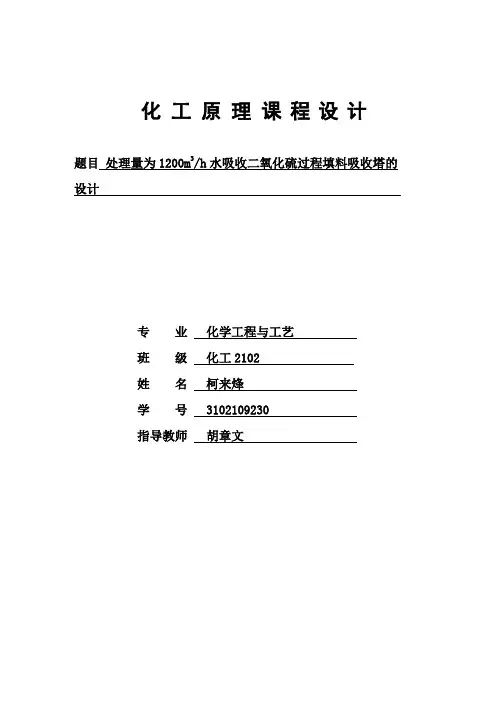
化工原理课程设计题目处理量为1200m3/h水吸收二氧化硫过程填料吸收塔的设计专业化学工程与工艺班级化工2102姓名柯来烽学号 3102109230指导教师胡章文化工原理设计任务书专业:化学工程与工艺班级:化工2102 设计人:柯来烽一.设计题目处理量为1200m3/h水吸收二氧化硫过程填料吸收塔的设计二.原始数据及条件进塔二氧化硫含量为8%(摩尔分率,下同),温度25℃。
塔顶易挥发组分回收率94% 。
进塔吸收剂温度20℃,由于气液比比较大,温度基本不变,吸收温度可近似取清水温度。
二氧化硫回收率为操作压强为常压三.设计要求1. 标题页;2. 设计任务书;3. 目录;4. 确定设计方案;5. 填料塔吸收的塔径,填料层高度,塔高和填料层压降的计算;6. 塔及主要附属构件结构尺寸设计;7. 设计一览表;8. 对本设计的评述;9. 绘制填料塔装备图;10. 参考文献。
四.设计日期: 2013 年 6 月 10 日至 2013 年 6月 20 日目录摘要 (1)1绪论 (2)1.1吸收技术概况 (2)1.2吸收设备发展 (2)1.3吸收在工业生产中的应用 (3)2设计方案 (4)2.1吸收方法及吸收剂的选择 (4)2.1.1吸收方法 (4)2.1.2吸收剂的选择: (4)2.2吸收工艺的流程 (5)2.2.1吸收工艺流程的确定 (5)2.2.2吸收工艺流程图及工艺过程说明 (6)2.3操作参数选择 (7)2.3.1操作温度的选择 (7)2.3.2操作压力的选择 (7)2.3.3吸收因子的选择 (7)2.4吸收塔设备及填料的选 (8)2.4.1吸收塔设备的选择 (8)2.4.2填料的选择 (8)3吸收塔工艺的算 (10)3.1基础性物性数据 (10)3.1.1液相物性数据 (10)3.1.2气相物性数据 (10)3.1.3气液平衡数据 (10)3.2物料衡算 (11)3.3塔径的计算及校核 (11)3.3.1塔径的计算 (11)3.3.2泛点率的计算 (13)3.3.3气体能动因子 (13)3.3.4填料规格校核 (13)3.3.5液体喷淋密度校核 (13)3.4填料层高度计算 (14)3.4.1传质单元数计算 (14)3.4.2传质单元高度计算 (14)3.4.3填料层高度的计算 (15)3.5 填料塔附属高度的计算.............................................................. (16)3.6 液体分布器的简要设计 (16)3.6.1 分布点密度及布液孔数的计算 (16)3.6.2布液计算 (17)3.6.3 塔底液体保持管高度的计算..................................................................... (17)3.7 其他附属塔内件的选择 (18)3.7.1液体再分布器 (18)3.7.2填料支撑板 (18)3.7.3 填料压紧装置与床层限制板 (18)3.7.4 气体进出口装置与排液装置 (18)3.8 吸收塔主要接管尺寸算 (19)3.9 填料层压力降的计算 (19)工艺设计计算结果汇总与主要符号说明 (21)结束语 (24)主要符号说明 (25)参考文献 (27)摘要在化工生产中,气体吸收过程是利用气体混合物中,各组分在液体中溶解度或化学反应活性的差异,在气液两相接触是发生传质,实现气液混合物的分离。
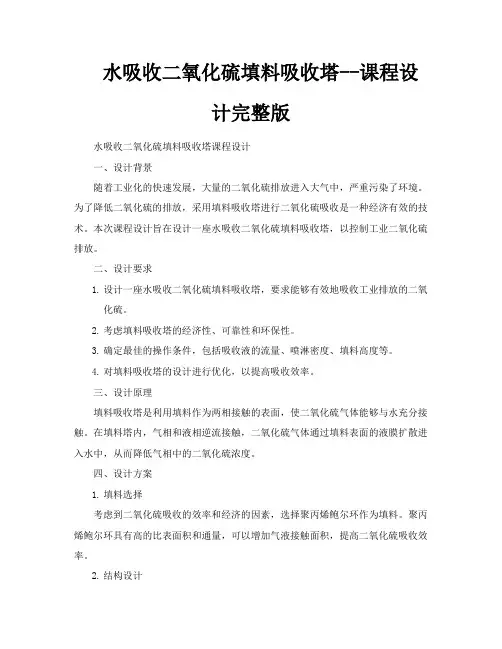
水吸收二氧化硫填料吸收塔--课程设计完整版水吸收二氧化硫填料吸收塔课程设计一、设计背景随着工业化的快速发展,大量的二氧化硫排放进入大气中,严重污染了环境。
为了降低二氧化硫的排放,采用填料吸收塔进行二氧化硫吸收是一种经济有效的技术。
本次课程设计旨在设计一座水吸收二氧化硫填料吸收塔,以控制工业二氧化硫排放。
二、设计要求1.设计一座水吸收二氧化硫填料吸收塔,要求能够有效地吸收工业排放的二氧化硫。
2.考虑填料吸收塔的经济性、可靠性和环保性。
3.确定最佳的操作条件,包括吸收液的流量、喷淋密度、填料高度等。
4.对填料吸收塔的设计进行优化,以提高吸收效率。
三、设计原理填料吸收塔是利用填料作为两相接触的表面,使二氧化硫气体能够与水充分接触。
在填料塔内,气相和液相逆流接触,二氧化硫气体通过填料表面的液膜扩散进入水中,从而降低气相中的二氧化硫浓度。
四、设计方案1.填料选择考虑到二氧化硫吸收的效率和经济的因素,选择聚丙烯鲍尔环作为填料。
聚丙烯鲍尔环具有高的比表面积和通量,可以增加气液接触面积,提高二氧化硫吸收效率。
2.结构设计填料吸收塔的结构包括塔体、进气管、出水管、填料支撑板和聚丙烯鲍尔环填料。
塔体采用圆形结构,直径为1.2m,高度为12m;进气管安装在塔顶部,用于引入二氧化硫气体;出水管位于塔底部,用于排出吸收后的废水;填料支撑板位于塔体中部,用于支撑聚丙烯鲍尔环填料。
3.操作条件在填料吸收塔的操作过程中,需要控制以下条件:(1)吸收液的流量:通过调整水泵的流量来控制吸收液的流量,使其保持在一个最佳值,以提高吸收效率。
(2)喷淋密度:通过调整喷嘴的数量和喷射角度来控制喷淋密度,使水能够均匀地分布在填料上,增加气液接触机会。
(3)填料高度:选择合适的填料高度,以确保气液充分接触,提高吸收效率。
五、设计优化1.增加填料层数:通过增加填料的层数,可以增加气液接触的机会,提高吸收效率。
但是填料层数过多会增加压降和塔的能耗,因此需要综合考虑。
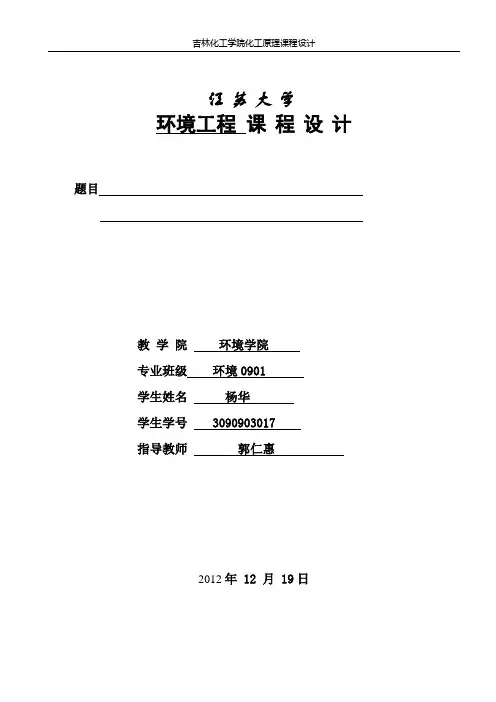
吉林化工学院化工原理课程设计江苏大学环境工程课程设计题目教学院环境学院专业班级环境0901学生姓名杨华学生学号 3090903017指导教师郭仁惠2012年 12 月 19日设计任务书1、设计题目:年处理量为 21720.96吨二氧化硫混合气的填料吸收塔设计;矿石焙烧炉送出的气体冷却到20℃后送入填料塔中,用20℃清水洗涤洗涤除去其中的SO2。
入塔的炉气流量为1000m3/h~2000 m3/h,其中进塔SO2的摩尔分率为0.02~0.03,要求SO2的排放含量0.3%~0.5%。
吸收塔为常压操作,因该过程液气比很大,吸收温度基本不变,可近似取为清水的温度。
吸收剂的用量为最小用量的1.3倍。
2、工艺操作条件:(1)操作平均压力:常压(2)操作温度:t=20℃(3)每年生产时间:7200h。
(4)填料类型及规格自选。
3、设计任务:完成吸收塔的工艺设计与计算,有关附属设备的设计和选型,绘制吸收系统的工艺流程图和吸收塔的工艺条件图,编写设计说明书。
目录摘要 (1)第1章绪论 (2)1.1吸收技术概况 (2)1.2吸收设备的发展 (2)1.3吸收在工业生产中的应用 (3)第2章设计方案 (5)2.1吸收剂的选择 (5)2.2吸收流程的选择 (6)2.2.1吸收工艺流程的确定 (6)2.2.2吸收工艺流程图及工艺过程说明 (7)2.3吸收塔设备及填料的选择 (7)2.3.1吸收塔的设备选择 (7)2.3.2填料的选择 (7)2.4吸收剂再生方法的选择 (8)2.5操作参数的选择 (9)2.5.1操作温度的选择 (9)2.5.2操作压力的选择 (9)2.5.3吸收因子的选择 (9)第3章吸收塔的工艺计算 (11)3.1基础物性数据 (11)3.1.1液相物性数据 (11)3.1.2气相物性数据 (11)3.1.3气液平衡数据....................................................................................... 错误!未定义书签。

水吸收二氧化硫过程填料吸收塔的设计说明吉林化工学院化工原理课程设计题目教学院化学与制药工程学院专业班级药剂0601学生姓名学生学号06240101指导教师2008年12 月19日设计任务书1、设计题目:年处理量为21720.96吨二氧化硫混合气的填料吸收塔设计;矿石焙烧炉送出的气体冷却到20℃后送入填料塔中,用20℃清水洗涤洗涤除去其中的SO2。
入塔的炉气流量为1000m3/h~2000 m3/h,其中进塔SO2的摩尔分率为0.02~0.03,要求SO2的排放含量0.3%~0.5%。
吸收塔为常压操作,因该过程液气比很大,吸收温度基本不变,可近似取为清水的温度。
吸收剂的用量为最小用量的1.3倍。
2、工艺操作条件:(1)操作平均压力:常压(2)操作温度:t=20℃(3)每年生产时间:7200h。
(4)填料类型及规格自选。
3、设计任务:完成吸收塔的工艺设计与计算,有关附属设备的设计和选型,绘制吸收系统的工艺流程图和吸收塔的工艺条件图,编写设计说明书。
目录摘要 (1)第1章绪论 (3)1.1吸收技术概况 (3)1.2吸收设备的发展 (3)1.3吸收在工业生产中的应用 (6)第2章设计方案 (9)2.1吸收剂的选择 (9)2.2吸收流程的选择 (10)2.2.1吸收工艺流程的确定 (10)2.2.2吸收工艺流程图及工艺过程说明 (12) 2.3吸收塔设备及填料的选择 (12)2.3.1吸收塔的设备选择 (12)2.3.2填料的选择 (13)2.4吸收剂再生方法的选择 (14)2.5操作参数的选择 (14)2.5.1操作温度的选择 (14)2.5.2操作压力的选择 (15)2.5.3吸收因子的选择 (15)第3章吸收塔的工艺计算 (18)3.1基础物性数据 (18)3.1.1液相物性数据 (18)3.1.2气相物性数据 (18)3.1.3气液平衡数据 (19)3.2物料衡算 (19)3.3填料塔的工艺尺寸的计算 (20)3.3.1塔径的计算 (20)3.3.2泛点率校核 (21)3.3.3填料规格校核: (21)3.3.4液体喷淋密度校核 (21)3.4填料塔填料高度计算 (22)3.4.1传质单元高度计算 (22)3.4.2传质单元数的计算 (23)3.4.3填料层高度计算 (24)3.5填料塔附属高度计算 (24)3.6液体分布器计算 (24)3.6.1液体分布器 (24)3.6.2布液孔数 (25)3.6.2塔底液体保持管高度 (25)3.7其他附属塔内件的选择 (26)3.7.1液体分布器 (26)3.7.2液体再分布器 (27)3.7.3填料支撑板 (27)3.7.4填料压板与床层限制板 (28)3.7.5气体进出口装置与排液装置 (28)3.8吸收塔的流体力学参数的计算 (28)3.8.1吸收塔的压力降 (28)3.8.2吸收塔的泛点率 (29)3.8.3气体动能因子 (29)3.9附属设备的计算与选择 (29)工艺设计计算结果汇总与主要符号说明 (31)主要符号说明 (32)设计过程的评述和有关问题的讨论 (35)主要参考文献 (37)附录 (39)结束语 (40)摘要在化工工业中,经常需要将气体混合物的各个组分加以分离,其主要目的是回收气体混合物中的有用物质,以制取产品,或除去工艺气体中的有害成分,使气体净化,以便进一步加工处理,或除去工业放空尾气中的有害成分,以免污染空气。
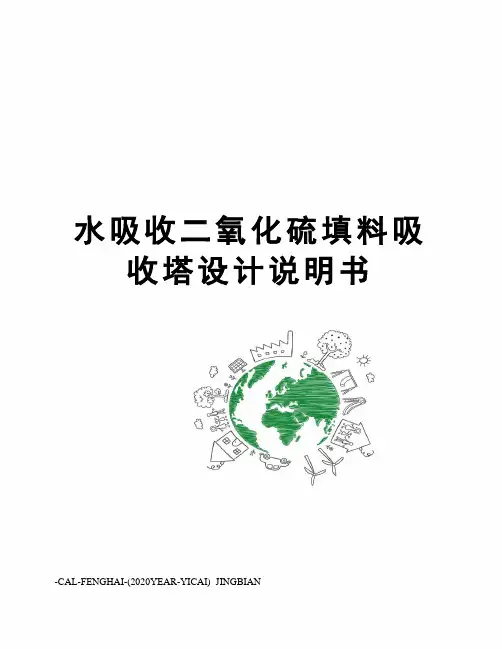
水吸收二氧化硫填料吸收塔设计说明书-CAL-FENGHAI-(2020YEAR-YICAI)_JINGBIAN化工原理课程设计题目处理量为1200m3/h水吸收二氧化硫过程填料吸收塔的设计专业化学工程与工艺班级化工2102姓名柯来烽学号 30指导教师胡章文化工原理设计任务书专业:化学工程与工艺班级:化工2102 设计人:柯来烽一.设计题目处理量为1200m3/h水吸收二氧化硫过程填料吸收塔的设计二.原始数据及条件进塔二氧化硫含量为8%(摩尔分率,下同),温度25℃。
塔顶易挥发组分回收率94% 。
进塔吸收剂温度20℃,由于气液比比较大,温度基本不变,吸收温度可近似取清水温度。
二氧化硫回收率为操作压强为常压三.设计要求1. 标题页;2. 设计任务书;3. 目录;4. 确定设计方案;5. 填料塔吸收的塔径,填料层高度,塔高和填料层压降的计算;6. 塔及主要附属构件结构尺寸设计;7. 设计一览表;8. 对本设计的评述;9. 绘制填料塔装备图;10. 参考文献。
四.设计日期: 2013 年 6 月 10 日至 2013 年 6月 20 日目录摘要 (1)1绪论 (2)吸收技术概况.............................................................................................................2 吸收设备发展.............................................................................................................2 吸收在工业生产中的应用.. (3)2设计方案 (4)吸收方法及吸收剂的选择 (4)吸收方法 (4)吸收剂的选择: (4)吸收工艺的流程 (5)吸收工艺流程的确定 (5)吸收工艺流程图及工艺过程说明 (6)操作参数选择 (7)操作温度的选择 (7)操作压力的选择 (7)吸收因子的选择 (7)吸收塔设备及填料的选 (8)吸收塔设备的选择 (8)填料的选择 (8)3吸收塔工艺的算 (10)基础性物性数据 (10)液相物性数据 (10)气相物性数据 (10)气液平衡数据 (10)物料衡算 (11)塔径的计算及校核 (11)塔径的计算 (11)泛点率的计算 (13)气体能动因子 (13)填料规格校核 (13)液体喷淋密度校核 (13)填料层高度计算 (14)传质单元数计算 (14)传质单元高度计算..........................................................................................................14 填料层高度的计算......................................................................................................15 填料塔附属高度的计算.............................................................. .......................................16 液体分布器的简要设计...................................................................................................16 分布点密度及布液孔数的计算...................................................................................16 布液计算..................................................................................................................................17 塔底液体保持管高度的计算..................................................................... ...............17 其他附属塔内件的选择....................................................................................................18 液体再分布器.............................................................................................................18 填料支撑板.......................................................................................................................18 填料压紧装置与床层限制板..................................................................................18 气体进出口装置与排液装置...................................................................................18 吸收塔主要接管尺寸算...............................................................................................19 填料层压力降的计算. (19)工艺设计计算结果汇总与主要符号说明.............................................................................21结束语...............................................................................................................................24主要符号说明...................................................................................................................25参考文献 (27)摘要在化工生产中,气体吸收过程是利用气体混合物中,各组分在液体中溶解度或化学反应活性的差异,在气液两相接触是发生传质,实现气液混合物的分离。
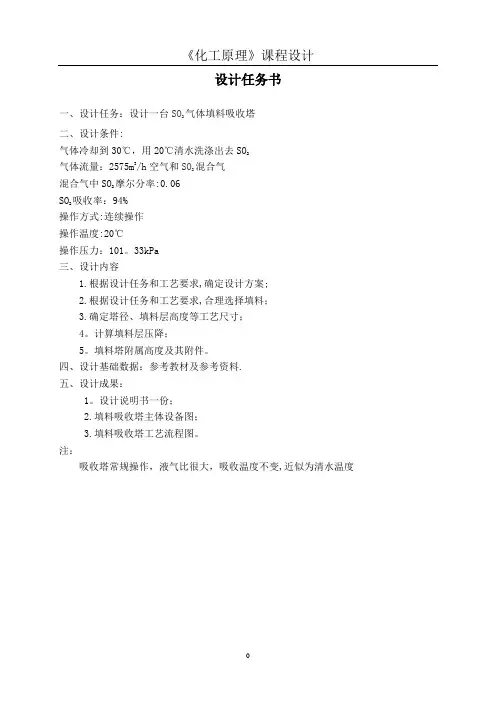
设计任务书一、设计任务:设计一台SO气体填料吸收塔2二、设计条件:气体冷却到30℃,用20℃清水洗涤出去SO2气体流量:2575m3/h空气和SO混合气2摩尔分率:0.06混合气中SO2吸收率:94%SO2操作方式:连续操作操作温度:20℃操作压力:101。
33kPa三、设计内容1.根据设计任务和工艺要求,确定设计方案;2.根据设计任务和工艺要求,合理选择填料;3.确定塔径、填料层高度等工艺尺寸;4。
计算填料层压降;5。
填料塔附属高度及其附件。
四、设计基础数据:参考教材及参考资料.五、设计成果:1。
设计说明书一份;2.填料吸收塔主体设备图;3.填料吸收塔工艺流程图。
注:吸收塔常规操作,液气比很大,吸收温度不变,近似为清水温度目录1、概述 (2)1。
1吸收的定义 (2)1。
2吸收的目的 (2)1。
3填料吸收塔简介 (2)2、设计方案简介 (2)2.1吸收剂的选择 (3)2。
2吸收流程的选择 (4)2.2。
1气体吸收过程分类 (4)2.2。
2吸收装置的流程 (4)2.3填料的类型和选择 (5)2。
4设计步骤 (6)3、工艺计算 (6)3.1基础物性数据 (6)3。
1.1液相物性数据 (6)3.1。
2气相物性数据 (6)3.1.3气液相平衡数据 (7)3。
1.4物料衡算 (7)3。
2填料塔的工艺尺寸的计算 (8)3.2。
1塔径的计算 (8)3.2。
2填料层高度计算 (11)3.2。
3填料层压降计算 (14)4、辅助设备的计算及选型 (15)4。
1除雾沫器 (15)4.2液体分布器简要设计 (15)4.3液体再分布器--—-升气管式液体再分布器 (17)4。
4填料支撑装置 (17)4。
5填料压紧装置 (17)4。
6气体和液体的进出口装置 (17)5、设计结果汇总 (19)6、主要符号说明 (20)7、设计评述 (21)8、参考文献 (22)1、概述1.1吸收的定义吸收是分离气体混合物的单元操作,其分离原理是利用气体混合物中各组分在液体溶剂中溶解度的差异来实现不同气体的分离。
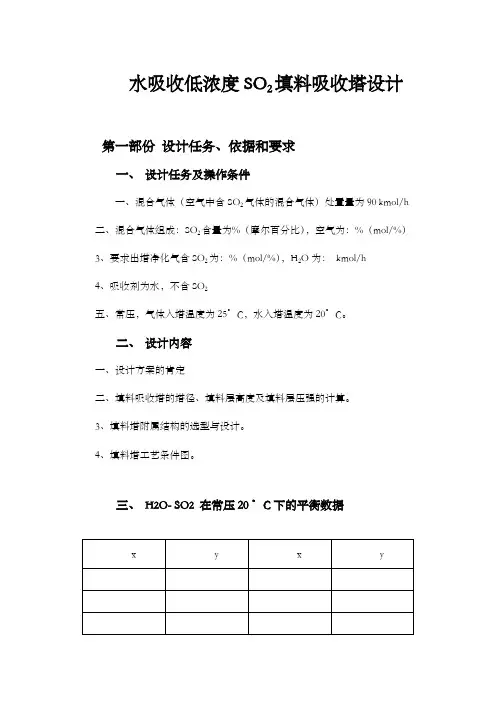
水吸收低浓度SO2填料吸收塔设计第一部份设计任务、依据和要求一、设计任务及操作条件一、混合气体(空气中含SO2气体的混合气体)处置量为90 kmol/h二、混合气体组成:SO2含量为%(摩尔百分比),空气为:%(mol/%)3、要求出塔净化气含SO2为:%(mol/%),H2O为:kmol/h4、吸收剂为水,不含SO2五、常压,气体入塔温度为25°C,水入塔温度为20°C。
二、设计内容一、设计方案的肯定二、填料吸收塔的塔径、填料层高度及填料层压强的计算。
3、填料塔附属结构的选型与设计。
4、填料塔工艺条件图。
三、H2O- SO2在常压20 °C下的平衡数据四、气体与液体的物理性质数据气体的物理性质:气体粘度«Skip Record If...»气体扩散系数«Skip Record If...»气体密度«Skip Record If...»液体的物理性质:液体粘度«Skip Record If...»液体扩散系数«Skip Record If...»液体密度«Skip Record If...»液体表面张力«Skip Record If...»五、设计要求一、设计计算说明书一份二、填料塔图(2号图)一张第二部份 SO2净化技术和设备一、SO2的来源、性质及其危害:一、二氧化硫的来源二氧化硫的来源很普遍,几乎所有企业都要产生二氧化硫,最主要途径是含硫化石燃料的燃烧。
大约一吨煤中含有5-50kg硫,一吨石油中含有5-30kg硫。
这些燃料经燃烧都产生并排放出二氧化硫,占所有排放总量的96%.二氧化硫的来源包括微生物活动,火山活动,丛林火灾和海水飞沫。
主要有自然来源和人为来源两大类:自然来源主如果火山活动,喷出的火山气体中含有大量的二氧化硫气体,地质深处的天然硫元素在火山喷发进程中燃烧氧化为二氧化硫,随火山灰一路喷射到大气中。
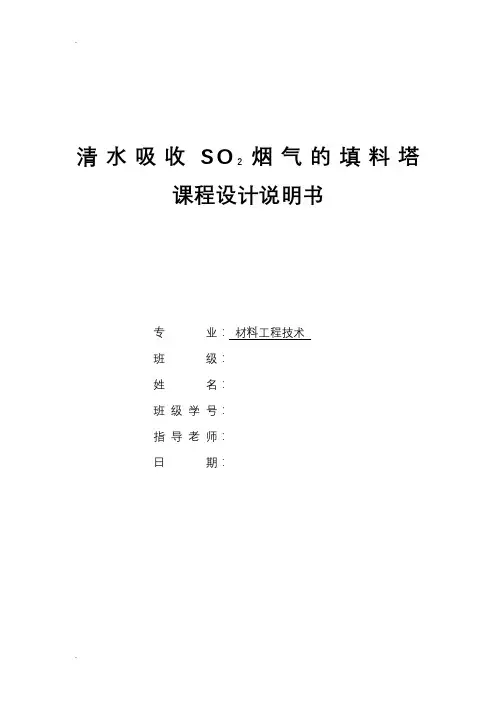
清水吸收S O2烟气的填料塔课程设计说明书专业:材料工程技术班级:姓名:班级学号:指导老师:日期:任务书《化工单元操作》课程设计任务书一、题目清水吸收SO2烟气的填料塔设计二、设计任务及操作条件1、气体处理量1000m3/h(30℃,100kpa)2、进塔气体的组成:9%(体积分数)SO2,其余可视为空气3、回收其中所含SO2的95%4、吸收塔的操作温度为30℃,压力位100kpa5、液气比为最小液气比的1.2倍6、空塔气速取泛点气速的0.65倍7、填料自选三、设计内容1、填料塔的物料衡算2、塔的主要工艺尺寸确定①塔高的确定②塔径的确定3、辅助设备的类型及作用4、绘制填料塔的设备图(CAD)5、编写设计说明书(电子版)目录第一章前言1吸收的概况2 吸收设备分类第二章设计方案2.1吸收剂的选择2.1.1 对溶质的溶解度大2.1.2 对溶质有较高的选择性2.1.3 不易挥发2.1.4 再生性能好2.2塔内气液流向的选择2.3吸收系统工艺流程2.3.1.工艺流程图及说明2.4填料的选择2.5操作参数的选择2.5.1操作温度2.5.2 操作压力的确定第三章工艺计算3.1 物料衡算3.2 吸收剂用量3.4 塔径计算3.5填料层高度计算第四章辅助设备的类型及作用4.1 液体分布器4.2 除雾器4.3 填料压紧装置4.4 填料支撑装置第五章结束语第六章主要符号说明第七章参考文献1 前言1.1 吸收技术的概况利用混合气体中各组分在同一种溶剂(吸收剂)中溶解度的不同分离气体混合物的单元操作称为吸收。
吸收是分离气体混合物最常见的单元操作之一。
工业吸收操作是在吸收塔内进行的。
在吸收操作中,通常将混合气体中能够溶解于溶剂中的组分称为溶质或吸收质,以A表示而不溶或微溶的组分称为载体或惰性气体,以B表示;吸收所用的溶剂称为吸收剂,以S表示;经吸收后得到的溶液称为吸收液;被吸收后排出吸收塔的气体称为吸收尾气。
吸收就是吸收质从气相转入液相的过程。
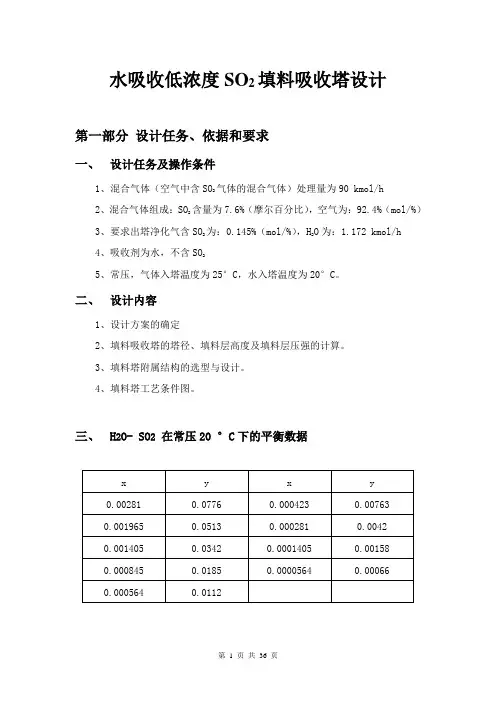
水吸收低浓度SO2填料吸收塔设计第一部分设计任务、依据和要求一、设计任务及操作条件1、混合气体(空气中含SO2气体的混合气体)处理量为90 kmol/h2、混合气体组成:SO2含量为7.6%(摩尔百分比),空气为:92.4%(mol/%)3、要求出塔净化气含SO2为:0.145%(mol/%),H2O为:1.172 kmol/h4、吸收剂为水,不含SO25、常压,气体入塔温度为25°C,水入塔温度为20°C。
二、设计内容1、设计方案的确定2、填料吸收塔的塔径、填料层高度及填料层压强的计算。
3、填料塔附属结构的选型与设计。
4、填料塔工艺条件图。
三、H2O- SO2在常压20 °C下的平衡数据四、 气体与液体的物理性质数据气体的物理性质:气体粘度()0.0652/G u kg m h =⋅ 气体扩散系数20.0393/G D m s = 气体密度31.383/G kg m ρ=液体的物理性质:液体粘度 3.6/()L u kg m h =⋅ 液体扩散系数625.310/L D m s -=⨯ 液体密度 3998.2/L kg m ρ=液体表面张力 4273/92.7110/L dyn cm kg h σ==⨯五、 设计要求1、设计计算说明书一份2、填料塔图(2号图)一张第二部分 SO2净化技术和设备一、SO2的来源、性质及其危害:1、二氧化硫的来源二氧化硫的来源很广泛,几乎所有企业都要产生二氧化硫,最主要途径是含硫化石燃料的燃烧。
大约一吨煤中含有5-50kg硫,一吨石油中含有5-30kg硫。
这些燃料经燃烧都产生并排放出二氧化硫,占所有排放总量的96%.二氧化硫的来源包括微生物活动,火山活动,森林火灾以及海水飞沫。
主要有自然来源和人为来源两大类:自然来源主要是火山活动,喷出的火山气体中含有大量的二氧化硫气体,地质深处的天然硫元素在火山喷发过程中燃烧氧化为二氧化硫,随火山灰一起喷射到大气中。
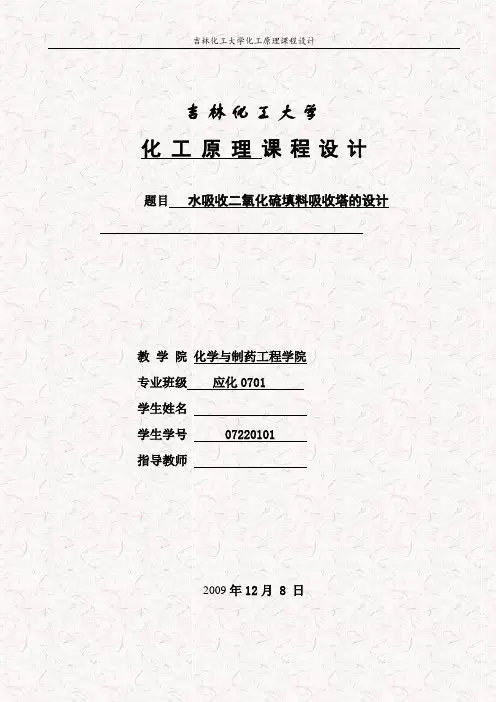
吉林化工大学化工原理课程设计题目水吸收二氧化硫填料吸收塔的设计教学院化学与制药工程学院专业班级应化0701学生姓名学生学号 07220101指导教师2009年12月 8 日化工原理课程设计任务书设计题目:水吸收二氧化硫填料吸收塔的设计1、设计题目:水吸收二氧化硫过程填料吸收塔的设计;矿石焙烧炉送出的气体冷却到20℃后送入填料塔中,用20℃清水洗涤除去其中的SO2。
入塔的炉气流量为1000m3/h,其中进塔SO2的摩尔分率为0.03,要求SO2的吸收率为99.99%。
吸收塔为常压操作,因该过程液气比很大,吸收温度基本不变,可近似取为清水的温度。
吸收剂的用量为最小用量的1.3倍。
2、工艺操作条件:(1)操作平均压力:常压(2)操作温度: t=20℃(3)每年生产时间: 7200h3、设计任务:1.完成干燥器的工艺设计与计算(包括塔径与塔高的计算,填料的选取)。
2.绘制吸收系统的工艺流程图,吸收塔的设备条件图。
3.编写该吸收塔的设计说明书。
目录摘要 ................................................................................................................................................ 错误!未定义书签。
1绪论............................................................................................................................................ 错误!未定义书签。
1.1气体吸收的概述 ....................................................................................................................... 错误!未定义书签。
水吸收二氧化硫填料吸收塔设计说明书示例文章篇一:《水吸收二氧化硫填料吸收塔设计说明书》嗨,大家好!今天我要和大家说说一个超级厉害又特别有趣的东西——水吸收二氧化硫填料吸收塔。
你可能会想,这是个啥呀?听我慢慢道来。
我呀,就像一个小小的发明家。
我在想,咱们生活的世界里有很多工厂会排出二氧化硫这种不好的气体呢。
二氧化硫就像一个调皮捣蛋的小恶魔,它跑到空气里,会让空气变得脏脏的,还会对我们的身体和环境造成很多危害。
那怎么办呢?这时候,水吸收二氧化硫填料吸收塔就像是一个超级英雄登场啦。
那这个吸收塔到底长啥样呢?它就像一个高高的大柱子。
里面呢,有着各种各样的填料。
这些填料就像是住在塔里的小居民,它们形态各异。
有的像小小的珠子,圆滚滚的;有的像一片片的小薄片,整整齐齐地排列着。
这些填料的存在可重要啦。
它们就好比是一个个小助手,在吸收二氧化硫的过程中发挥着巨大的作用。
我来给大家讲讲这个吸收塔的工作原理吧。
水就像一个温柔的大姐姐,它从吸收塔的上面慢慢地流下来。
而二氧化硫呢,就像一群不听话的小坏蛋,从吸收塔的下面往上跑。
当水和二氧化硫相遇的时候呀,就像是一场激烈的战斗。
水这个大姐姐可不会放过二氧化硫这些小坏蛋。
她张开自己的怀抱,把二氧化硫一点点地拉到自己的身边。
这时候,填料这些小居民也没闲着,它们就像是一个个小媒人,在水和二氧化硫之间牵线搭桥,让水能够更好地吸收二氧化硫。
我想象着在工厂里,有这样的场景呢。
工程师叔叔站在吸收塔旁边,他看着这个吸收塔,就像看着自己的宝贝孩子一样。
旁边有个小徒弟好奇地问:“叔叔,这个吸收塔为啥就能把二氧化硫给抓住呢?”工程师叔叔笑着说:“哈哈,孩子啊,这就像你用一个大网去抓小鱼一样。
水就是那个大网,填料就是网上面的那些小钩子,二氧化硫就像小鱼,被网和钩子一起就抓住喽。
”小徒弟眼睛亮晶晶的,好像一下子就明白了。
那这个吸收塔的大小怎么确定呢?这可需要我们好好地计算一番呢。
我们要考虑工厂排出的二氧化硫的量有多少。
《化工原理课程设计》报告设计任务书(一)设计题目试设计一座填料吸收塔,用于脱除混于空气中的SO2,混合气体的处理为2500m3/h,其中SO2(体积分数)8﹪。
要求塔板排放气体中含SO2低于0.4%,采用清水进行吸收。
(二)操作条件常压,20℃(三)填料类型选用塑料鲍尔环、陶瓷拉西环填料规格自选(四)设计内容1、吸收塔的物料衡算2、吸收塔的工艺尺寸计算3、填料层压降的计算4、吸收塔接管尺寸的计算5、绘制吸收塔的结构图6、对设计过程的评述和有关问题的讨论7、参考文献8、附表目录一、概述 (4)二、计算过程 (4)1. 操作条件的确定 (4)1.1吸收剂的选择 (4)1.2装置流程的确定 (4)1.3填料的类型与选择 (4)1.4操作温度与压力的确定 (4)2. 有关的工艺计算 (5)2.1基础物性数据 (5)2.2物料衡算 (6)2.3填料塔的工艺尺寸的计算 (6)2.4填料层降压计算 (11)2.5吸收塔接管尺寸的计算 (12)2.6附属设备……………………………………………… ..12三、评价 (13)四、参考文献 (13)五、附表 (14)一、概述填料塔不但结构简单,且流体通过填料层的压降较小,易于用耐腐蚀材料制造,所以它特别适用于处理量小,有腐蚀性的物料及要求压降小的场合。
液体自塔顶经液体分布器喷洒于填料顶部,并在填料的表面呈膜状流下,气体从塔底的气体口送入,流过填料的空隙,在填料层中与液体逆流接触进行传质。
因气液两相组成沿塔高连续变化,所以填料塔属连续接触式的气液传质设备。
二、设计方案的确定(一) 操作条件的确定1.1吸收剂的选择因为用水作吸收剂,同时SO2不作为产品,故采用纯溶剂。
1.2装置流程的确定用水吸收SO2属于中等溶解度的吸收过程,故为提高传质效率,选择用逆流吸收流程。
1.3填料的类型与选择用不吸收SO2的过程,操作温度低,但操作压力高,因为工业上通常选用塑料散堆填料,在塑料散堆填料中,塑料鲍尔环填料的综合性能较好。
课程设计课程名称:化工原理课程设计设计题目:水吸收二氧化硫烟气的填料塔设计学院:环境科学与工程学院专业:再生资源科学与技术年级: XXX级学生姓名: XXX 指导教师: XXX 日期: 2013.6.24-2013.7.5课程设计任务书一、设计任务及操作条件烟气的填料塔设计设计题目:水吸收SO2操作条件:(1)混合烟气处理量为1000m3/h(30℃,100KN/m2);,其余可视为空气;(2)进塔气体组成:9%(体积比)SO2(3)回收其中所含SO的95%;2(4)吸收塔操作温度为30℃,压力位100KN/m2;(5)液气比为最小液气比的1.2倍;(6)空塔气速取泛点气速的0.65倍;(7)填料:自选;二、设计内容1.设计方案的选择及流程的确定;2.塔的物料衡算和热量衡算;3.塔的主要工艺尺寸确定:(1)塔高的确定;(2)塔径的确定;(3)全塔压降的验算;4.辅助设备的选型与计算;5.绘制工艺流程图;6.绘制填料塔设备图;7.编写设计说明书。
摘要:吸收是分离气体混合物的单元操作,其分离原理是利用气体混合物中各组分在液体溶剂中溶解度的差异来实现不同气体的分离。
一个完整的吸收过程应包括吸收和解吸两部分。
气体吸收过程是利用气体混合物中,各组分在液体中溶解度或化学反应活性的差异,在气液两相接触时发生传质,实现气液混合物的分离。
在化工生产过程中,原料气的净化,气体产品的精制,治理有害气体,保护环境等方面都广泛应用到气体吸收过程。
本次化工原理课程设计的目的是根据设计要求采用填料吸收塔的方法处理含有二氧化硫的混合物,使其达到排放标准,采用填料吸收塔吸收操作是因为填料可以提供巨大的气液传质面积而且填料表面具有良好的湍流状况,关键词:吸收单元操作解析目录第1章绪论 (1)1.1吸收技术概况 (1)1.2吸收在工业生产中的应用 (2)1.3 吸收设备的发展 (2)第2章设计方案 (4)2.1吸收剂的选择 (4)2.2 吸收流程的选择 (5)2.2.1 气体吸收过程分类 (5)2.2.2 吸收装置的流程 (5)2.3吸收塔设备及填料的选择 (6)2.3.1 吸收塔设备 (6)2.3.2 填料的选择 (7)2.4吸收剂再生方法的选择 (7)2.5操作参数的选择 (8)2.5.1操作温度的确定 (8)2.5.2操作压力的确定 (8)第3章吸收塔工艺条件的计算 (10)3.1基础物性数据 (10)3.1.1液相物性数据 (10)3.1.2气相物性数据 (10)3.1.3气液两相平衡时的数据 (10)3.2物料衡算 (11)3.3填料塔的工艺尺寸计算 (11)3.3.1塔径的计算 (11)3.3.2泛点率校核和填料规格 (12)3.3.3液体喷淋密度校核 (13)3.4填料层高度计算 (13)3.4.1传质单元数的计算 (13)3.4.2传质单元高度的计算 (13)3.4.3填料层高度的计算 (14)3.5填料塔附属高度的计算 (14)3.6液体分布器的简要设计 (15)3.6.1液体分布器的选型 (15)3.6.2分布点密度及布液孔数的计算 (16)3.6.3塔底液体保持管高度的计算 (17)3.7其它附属塔内件的选择 (17)3.7.1 填料支撑板 (17)3.7.2 填料压紧装置与床层限制板 (17)3.7.3气体进出口装置与排液装置 (18)3.8流体力学参数计算 (18)3.8.1填料层压力降的计算 (18)3.8.2吸收塔主要接管的尺寸计算 (19)3.8.3离心泵的计算与选择 (20)第4章工艺设计计算结果汇总与主要符号说明 (23)4.1填料塔工艺尺寸计算结果表 (23)4.2流体力学参数计算结果汇总 (24)4.3附属设备计算结果汇总 (24)D聚丙烯塑料阶梯环填料主要性能参数汇总 (25)4.4所用38N4.5主要符号说明 (25)第5章设计方案讨论 (27)第6章心得体会 (28)附录 (29)参考文献 (32)第1章绪论1.1吸收技术概况利用混合气体中各组分在同一种溶剂(吸收剂)中溶解度的不同分离气体混合物的单元操作称为吸收。
吉林化工学院化工原理课程设计题目处理量为3100m3/h水吸收二氧化硫过程填料吸收塔的设计教学院专业班级学生姓名学生学号指导教师2011 年 12 月 5 日课程设计任务书1、设计题目:处理量为2550~3200m3/h水吸收二氧化硫过程填料吸收塔的设计。
矿石焙烧炉送出的气体冷却到20℃后送入填料塔中,用20℃清水洗涤洗涤除去其中的SO2入塔的炉气流量为3100m3/h,其中进塔SO2的摩尔分率为0.05,要求SO2的吸收率为95%。
吸收塔为常压操作,因该过程液气比很大,吸收温度基本不变,可近似取为清水的温度。
吸收剂的用量为最小用量的1.5倍。
2、工艺操作条件:(1)操作平均压力常压(2)操作温度t=20℃(3)选用填料类型及规格自选。
3、设计任务:完成吸收塔的工艺设计与计算,有关附属设备的设计和选型,绘制吸收系统的工艺流程图和吸收塔的工艺条件图,撰写设计说明书。
处理量为3100m3/h水吸收二氧化硫过程填料吸收塔的设计化工原理教学与实验中心 2011年11月目录摘要 (IV)第一章绪论 (1)1.1 吸收技术概况 (1)1.2 吸收设备发展 (1)1.3 吸收在工业生产中的应用 (3)第二章吸收塔的设计方案 (4)2.1 吸收剂的选择 (4)2.2 吸收流程选择 (5)2.2.1 吸收工艺流程的确定 (5)2.2.2 吸收工艺流程图及工艺过程说明 (6)2.3 吸收塔设备及填料的选择 (7)2.3.1 吸收塔设备的选择 (7)2.3.2 填料的选择 (8)2.4 吸收剂再生方法的选择 (10)2.5 操作参数的选择 (11)2.5.1 操作温度的确定 (11)2.5.2 操作压强的确定 (11)第三章吸收塔工艺条件的计算 (12)3.1 基础物性数据 (12)3.1.1 液相物性数据 (12)3.1.2 气相物性数据 (12)3.1.3 气液两相平衡时的数据 (12)3.2 物料衡算 (12)3.3 填料塔的工艺尺寸计算 (13)3.3.1 塔径的计算 (13)3.3.2 泛点率校核和填料规格 (14)3.3.3 液体喷淋密度校核 (15)3.4 填料层高度计算 (15)3.4.1 传质单元数的计算 (15)3.4.2 传质单元高度的计算 (16)3.4.3 填料层高度的计算 (17)3.5 填料塔附属高度的计算 (18)3.6 液体分布器的简要设计 (18)3.6.1 液体分布器的选型 (18)3.6.2 分布点密度及布液孔数的计算 (19)3.6.3 塔底液体保持管高度的计算 (20)3.7 其他附属塔内件的选择 (21)3.7.1 填料支撑板 (21)3.7.2 填料压紧装置与床层限制板 (21)3.7.3 气体进出口装置与排液装置 (21)3.8 流体力学参数计算 (22)3.8.1 填料层压力降的计算 (22)3.8.2 泛点率 (23)3.8.3 气体动能因子 (23)3.9 附属设备的计算与选择 (23)3.9.1 吸收塔主要接管的尺寸计算 (23)3.9.2 离心泵的计算与选择 (24)工艺设计计算结果汇总与主要符号说明 (26)设计方案讨论 (31)附录(计算程序及有关图表) (32)参考文献 (34)结束语 (35)带控制点的工艺流程图 (36)设备条件图 (37)化工原理课程设计教师评分表 (38)摘要吸收是利用混合气体中各组分在液体中的溶解度的差异来分离气态均相混合物的一种单元操作。
在化工生产中主要用于原料气的净化,有用组分的回收等。
气液两相的分离是通过它们密切的接触进行的,在正常操作下,气相为连续相而液相为分散相,气相组成呈连续变化,气相中的成分逐渐被分离出来。
填料塔是气液呈连续性接触的气液传质设备,属微分接触逆流操作过程。
塔的底部有支撑板用来支撑填料,并允许气液通过。
支撑板上的填料有整砌和乱堆两种方式。
填料层的上方有液体分布装置,从而使液体均匀喷洒于填料层上。
填料层的空隙率超过90%,一般液泛点较高,单位塔截面积上填料塔的生产能力较高,研究表明,在压力小于0.3MPa时,填料塔的分离效率明显优于板式塔。
这次课程设计的任务是用水吸收空气中的二氧化硫,然后再进行解吸处理得到二氧化硫。
要求设计包括塔径、填料塔高度、塔管的尺寸等,需要通过物料衡算得到所需要的基础数据,然后进行所需尺寸的计算得到各种设计参数,为图的绘制打基础,提供数据参考。
AbstractUsing mixed gas absorption is of components of the solubility in liquid phase difference to separate gaseous mixture are a unit operations. In the chemical production is mainly used for the purification of the gas material, useful components of the recovery, etc.Two-phase separation is through them close contact, in normal operation, the gas phase for continuous phase and liquid for the dispersed phase, and the gas phase composition is continuous change, the ingredients in gas phase gradually is isolated. Packing tower is a continuity of gas and liquid contact with gas and liquid mass transfer equipment, belong to differential contact against the operation of the process. The bottom of the tower has support plate used to support packing, and allow gas to liquid through. Support board packing to have entire build by laying bricks or stones and heaps in two ways. Packing layer above the liquid distribution device, thus causes the liquid uniform sprayed the packing layer. Packing layer of air void of more than 90%, and the average liquid the high point, the unit cross-sectional area tower on packed tower production capacity is higher, the research indicates that, in less than 0.3 MPa pressure, packed tower separation efficiency of the plate column is superior.This course is the task of designing water absorption in the air the sulfur dioxide, and then get desorption processing sulfur dioxide. Asked to design includes towers diameter, packed tower height, tower the size of the tube and so on, needs through the material balance calculations needed to get the basic data, then calculated the required size of design parameters, and for drawing found, provide data reference.第一章绪论1.1吸收技术概况当气体混合物与适当的液体接触,气体中的一个或者几个组分溶解与液体中,而不能溶解的组分仍留在气体中,使气体得以分离。
吸收过程是化工生产中常用的气体混合物的分离操作,其基本原理是利用混合物中各组分在特定的液体吸收剂中的溶解度不同,实现各组分分离的单元操作。
实际生产中,吸收过程所用的吸收剂常需回收利用,故一般来说,完整的吸收过程应包括吸收和解吸两部分,因而在设计上应将两部分综合考虑,才能得到较为理想的设计结果。
作为吸收过程的工艺设计,其一般性问题是在给定混合气体处理量、混合气体组成、温度、压力以及分离要求的条件下,完成以下工作:(1)根据给定的分离任务,确定吸收方案;(2)根据流程进行过程的物料和热量衡算,确定工艺参数;(3)依据物料及热量衡算进行过程的设备选型或设备设计;(4)绘制工艺流程图及主要设备的工艺条件图;(5)编写工艺设计说明书]1[。
1.2吸收设备发展在吸收过程中,质量交换是在两相接触面上进行的。
因此,吸收设备应具有较大的气液接触面,按吸收表面的形成方式,吸收设备可分为下列几类:(1)表面吸收器吸收器中两相间的接触面是静止液面(表面吸收器本身的液面)或流动的液膜表面(膜式吸收器)。
这类设备中的接触表面在相当大的程度上决定于吸收器构件的几何表面。
这类设备还可分为以下几种基本类型:a水平液面的表面吸收器:在这类吸收器中,气体在静止不动或缓慢流动的液面上通过,液面即为传质表面,由于传质表面不大,所以此种表面吸收器只适用于生产规模较小的场合。
通常将若干个气液逆流运动的吸收器串联起来使用。
为了能使液体自流,可将吸收器排列成阶梯式,即沿流体的流向,后一个吸收器低于前一个吸收器。
水平液面的表面吸收器的效率极低,现在应用已很有限。
只有从体积量不大的气体中吸收易溶组分,并同时需要散除热量的情况下才采用它们。
这类吸收器有时还用于吸收高浓度气体混合物中的某些组分。
b液膜吸收器:在液膜吸收器中,气液两相在流动的液膜表面上接触。
液膜是沿着圆管或平板的纵向表面流动的。
已知有三种类型的液膜吸收器:列管式吸收器:液膜沿垂直圆管的内壁流动;板状填料吸收器:填料是一些平行的薄板,液膜沿垂直薄板的两测流动;升膜式吸收器:液膜向上(反向)流动。